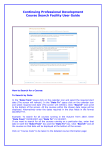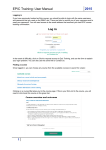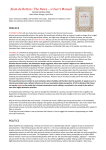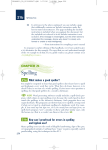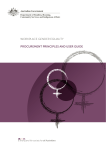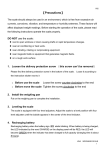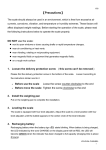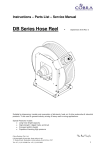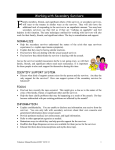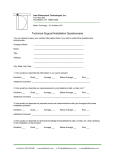Download Resident Reviewers Project - Current consultations
Transcript
Report written December 2009 Resident Reviewers Project: Home Fire Safety Visits exercise Gary Wilson Consultation and Research Officer Royal Borough of Kensington and Chelsea 020 7361 3616 [email protected] Summary of results The below information is a brief summary of the findings from this exercise. More detailed analysis can be found in the main body of this report. Background This exercise assessed home fire safety visits carried out by the Fire Brigade. Reviewers evaluated the visit and reported back on the experience. A total of 14 Reviewers took part each receiving a personal visit to their property. Visit timings The majority of Reviewers reported that the officer visiting them arrived promptly for their appointment. This wasn’t the case in three visits; however Reviewers appreciated being telephoned to let them know the situation. The majority of Reviewers were very satisfied with the promptness of the officer. Officer’s introduction All Reviewers reported that the officer introduced themselves and all but one reported that the officer showed identification. However, one Reviewer would have preferred both officers to show identification (as only one did). Reviewers appreciated the extra security of a pre-arranged password to confirm identity. However, in one call the officer forgot to say this at the beginning of the visit and in one visit the officer got the password slightly wrong. Officer’s advice In the majority of visits Reviewers reported that the officer explained what was to be covered, although two disagreed including one who reported that the officer startied talking about fitting a smoke alarm before explaining about fire safety. Reviewers explained the topics covered in their visit and some appreciated the advice specifically targeted to their circumstances. All found the advice helpful and understandable, although one felt there was a lot to take in, so could have benefitted from a summary. Smoke alarms Eight of the Reviewers had smoke alarms fitted as part of the exercise. All of these reported that care and attention was shown when fitting them and all reported that testing and maintenance instructions were given. The officer All reported that the officer visiting was polite, helpful, spoke clearly and used plain English that was jargon free. Overall satisfaction All Reviewers were satisfied with the experience (including 13 that were very satisfied) and all would recommend a home fire safety visit to a friend or relative. Resident Reviewers Project: Home fire safety visit exercise 1 Introduction Introduction This report contains the findings of the mystery shopping exercise of home fire safety visits. The exercise is part of a wider programme of mystery shopping exercises carried out under the Resident Reviewers Project banner. Background to the project Resident Reviewers is a corporate project established in response to the Leader’s challenge of “getting back to our core business of responding to residents”. Resident Reviewers are members of the public recruited to help test Council services via mystery shopping exercises. Mystery shopping involves asking for help with made up, but realistic enquiries (e.g. going to a Library and asking for help to find a book). Resident Reviewers rate the quality of their experience and feed back their findings in order to help us to improve services. The Resident Reviewers project is a good way of assessing the quality of service that the Council provides and in particular the customer care that the Council offers. Usually mystery shopping exercises (carried out by Resident Reviewers) are focused on Council services, or services carried out by organisations on behalf of the Council. However, the project is keen to work with partner organisations to help them to assess services that impact on the residents of Kensington and Chelsea. That is why in this exercise the Council is working with the Fire Brigade to assess what it is like to have a home fire safety visit. Background to home fire safety visits Home fire safety visits are available to all residents of the borough, regardless of housing tenure and personal circumstances (although visits are targeted at those who are at highest risk of fire). Home fire safety checks are completely free. The visits are carried out during the day and into the early evening and appointments need to be booked. The visits focus on three key areas: 1. Identifying potential fire risks within a property 2. Explaining what to do in order to reduce or prevent these risks 3. Putting together an escape plan in case a fire does break out and ensure the property has working smoke alarms. Where appropriate a free smoke alarm is fitted which has a ten year battery. Objectives of the exercise Each Fire Brigade Borough Commander has targets for the number of home fire safety visits that should be carried out in each borough each year. Alongside these targets, a quality assurance checklist exists to ensure that visits are carried out to a high standard. This exercise provided the Fire Brigade with a valuable insight in to residents’ current experience of undergoing a home fire safety visit in Kensington and Chelsea. The exercise focused on: • Punctuality • Quality of advice • Ease of understanding the advice • If a fire alarm is fitted how well this is carried out • Officer’s friendliness and other customer service aspects Resident Reviewers Project: Home fire safety visit exercise 2 Introduction Methodology Mystery shopping was carried out solely in personal visits in Reviewers’ homes. A total of 15 visits were made in October and November 2009, although one Reviewer had not returned their forms when this report was written. Reviewers were supplied with an evaluation form, covering areas detailed in ‘Objectives of the exercise’ above. Calculating results This report contains the analysis of evaluation forms completed by Resident Reviewers. Where graphs are shown, actual numbers of responses are shown and not percentage figures, this is due to the low base (number of respondents) involved in such an exercise. In the report the term officer is used to report on the member of staff or members of staff carrying out the visit, as in many visits more than one officer visited the property. It should be noted that not all Resident Reviewers responded to every question and this is why the figures shown in graphs will not always total the same. Reliability of results It is worth remembering that mystery shopping exercises will not produce statistically reliable results in the same way as a well-constructed questionnaire. However, the advantage of a mystery shopping exercise is the depth that each reviewer can go into, digging below the surface that cannot be achieved through quantitative methods alone. For more information For information on the results please contact Gary Wilson, Consultation and Research Officer on 020 7361 3616 or e-mail on [email protected] Resident Reviewers Project: Home fire safety visit exercise 3 Results: Visit logistics Appointment time In some cases Reviewers were offered a specific time for their visit (e.g. 10.30am), in other cases Reviewers were offered a morning or afternoon appointment (e.g. 10am – 1pm). Promptness of visit Resident Reviewers were asked to indicate how prompt the officer was for their appointment. In ten of the visits Reviewers reported that the officer arrived promptly for the appointment. However, in three visits this was not the case Where officers were late for their appointment, Reviewers were asked to indicate how late they were. Four Reviewers reported that officers arrived late (five minutes, ten minutes, 30 minutes and 45 minutes). Number of late visits Visits where officers were late Waiting times if officer was late Shortest wait Average Longest wait 4* 5 minutes 22 minutes 30 seconds 45 minutes * Although one Reviewer reported a late time, they had previously indicated they arrived promptly. Satisfaction with the promptness of the officer In addition to indicating their satisfaction with the promptness of the officer, Reviewers were also offered the opportunity to comment on this. Comments have been used to highlight analysis, but a full list can be seen in appendix 1. In the vast majority of visits (11) Reviewers were very satisfied with the promptness of the officer; additionally one Reviewer was fairly satisfied, for example: “Arrived slightly early!” Resident Reviewer receiving a home fire safety visit “The officers arrived at 2pm, more or less, which was the time we had scheduled the appointment for. I was busy working at the time (given my past experiences with expected visitors, especially workers, turning up incredibly late, I didn't expect them to be so prompt), so was a bit unprepared when they turned up.” Resident Reviewer receiving a home fire safety visit “The officers arrived together promptly.” Resident Reviewer receiving a home fire safety visit Resident Reviewers Project: Home fire safety visit exercise 4 Results: Visit logistics However, in one visit a Reviewer was neither satisfied nor dissatisfied and four Reviewers made comments that the officer had arrived late. In most of these visits the officer rang to inform the Reviewer that they were running late, for example: “Officer telephoned at 11.15 to say probably would be delayed by heavy traffic. In fact only arrived five minutes after 11.30. I regard that as prompt attendance.” Resident Reviewer receiving a home fire safety visit “The officer arrived only 10 minutes after the agreed time. I was very satisfied with the timing as it would have been difficult to find a space to park the car.” Resident Reviewer receiving a home fire safety visit “The officer called at 1.30 to say that he was on his way and that traffic was the reason for the delay.” Resident Reviewer receiving a home fire safety visit Resident Reviewers Project: Home fire safety visit exercise 5 Results: Introduction Introduction Reviewers were asked about the introduction from the officer when they arrived. As well as answering specific questions Resident Reviewers were asked to comment generally on the introduction, this has been used to highlight aspects of the analysis. A full list of comments can be seen in appendix 2. Introduction of the officer In all reported visits (13) Reviewers reported that the officer introduced themselves when they arrived, for example: “Both officers, two arrived, introduced themselves and carried identification.” Resident Reviewer receiving a home fire safety visit “The officers introduced themselves and showed me their identification. They were wearing their Fire Brigade uniforms and looked professional.” Resident Reviewer receiving a home fire safety visit “Introduction was carried out in an appropriate manner.” Resident Reviewer receiving a home fire safety visit Identification In all except one visit Reviewers reported that the officer showed identification when they arrived, for example: “They showed identification and were extremely polite.” Resident Reviewer receiving a home fire safety visit “The ID was worn and also his name and surname were on the booklet that he provided me.” Resident Reviewer receiving a home fire safety visit In two visits Reviewers commented that only one of the two officers that visited showed their identification: “I definitely would have preferred to be shown ID of both officers. I was surprised they weren't wearing photo ID cards around their necks or pinned to clothing.” Resident Reviewer receiving a home fire safety visit “The officer who made the appointment showed me his ID and also quoted a password I had chosen when he called to make the appointment. He introduced his colleague who didn't show ID but was wearing uniform.” Resident Reviewer receiving a home fire safety visit Resident Reviewers Project: Home fire safety visit exercise 6 Results: Introduction A number of Reviewers also commented that the officer used a pre agreed password when they arrived to confirm their identity, for example: “Officer confirmed his identification by giving a pre-arranged password.” Resident Reviewer receiving a home fire safety visit “I opened the door and ID was shown and they also repeated the password agreed when the appointment was agreed last week.” Resident Reviewer receiving a home fire safety visit However, in one visit a Reviewer reported they were not shown identification. One Reviewer also commented that the officer had forgotten to use the pre-arranged password and in one case got the password slightly wrong: “Also surprised and disappointed that the agreed code word was forgotten at the introductory stage although the officer did remember it later and apologised for not using it on arrival.” Resident Reviewer receiving a home fire safety visit “There was a slight hiccup with the password. The officer gave a password that rhymed with mine but began with a different letter. However, it was a minor error. The officers had shown ID and one of them had made the appointment. On these facts I agreed to let them enter my home.” Resident Reviewer receiving a home fire safety visit Resident Reviewers Project: Home fire safety visit exercise 7 Results: Advice given Advice When an officer undertakes a home fire safety visit they often offer advice to the householder on fire safety. As well as answering specific questions Resident Reviewers were asked to comment generally on the advice offered, this has been used to highlight aspects of the analysis. A full list of comments can be seen in appendices 3, 4 and 5. Content of the visit In the majority of visits (12) Reviewers reported that the officer explained what would be covered in the visit. However, in two visits this was not the case, for example: “Officer started to talk about where to put alarms before he told me what he would cover in the visit. I would have preferred to talk about safety advice (and hazards) first.” Resident Reviewer receiving a home fire safety visit Fire safety advice All Reviewers were given fire safety advice. Reviewers were asked to indicate which topic areas were covered. These tended to include dangers of smoking, cooking safely, use of candles, portable heating devices, open fires, electrical safety, smoke alarms, escape plans and bed time routine, for example: “Topics covered were candles, cooking oil, effects of smoke, cigarettes (cause and effect), recommended night time safety routines (closing doors, turning power sockets off), plan of action ahead of time should a fire occur, escape routes. Who to telephone, the best courses of action in dealing with a fire or cooking hazard.” Resident Reviewer receiving a home fire safety visit “It covered: Cooking - preferably to stay with your cooking and never leave unattended, use of candles - don't use near combustible materials and never leave unattended, electrical safety - to use the new type of long adaptors that can carry load rather than one types (single one) and shutting doors trying to keep safe should you have a fire.” Resident Reviewer receiving a home fire safety visit In some cases Reviewers also spoke about specific advice as well, for example “I was advised on the safety position, especially in the case of my mirror positioned above a gas fire, posing potential fire hazards.” Resident Reviewer receiving a home fire safety visit Resident Reviewers Project: Home fire safety visit exercise 8 Results: Advice given Helpfulness of advice In all visits Reviewers reported that the advice was helpful. A number of Reviewers also mentioned the practical nature of the advice (which they liked), for example: “There was some discussion about fire (smoke) alarms and they dealt with my questions helpfully.” Resident Reviewer receiving a home fire safety visit “The officers gave me very comprehensive advice which will be easy to follow. It was all about very simple steps which can make a lot of difference in case of a fire. They spoke very clearly and gave me very practical examples on what to do and what not to do.” Resident Reviewer receiving a home fire safety visit However, one Reviewer felt there was a lot to take in and felt a summary at the end would have been useful: “Extremely helpful, practical advice, tips and recommendations, however there was so much to take in I wasn't at all sure I'd remember all of it. A summary of the main points covered at the end would have been helpful to give I think. However, the officer wrote his name and number on the booklet and said I could call with any further queries or if clarification was needed. I was reassured by this and found it very considerate. Advice was tailored to my flat, lifestyle and situation which was great as I could relate to it all really well.” Resident Reviewer receiving a home fire safety visit Ease of understanding All Reviewers reported that advice was easy to understand and some went on to report that the officer dealt with questions well too, for example: “Officers explained in simple language which was easy to understand and left me a contact name and number should I have further enquiries.” Resident Reviewer receiving a home fire safety visit “The advice was given in a clear way and all my questions were answered fully. There were several sensible suggestions which I will implement.” Resident Reviewer receiving a home fire safety visit Resident Reviewers Project: Home fire safety visit exercise 9 Results: Advice given Leaflets and literature All Reviewers reported that the officer left leaflets or literature. This usually consisted of a ‘Fire Safety in the Home’ leaflet and a copy of the home fire safety visit form. Where Reviewers had had smoke alarms fitted they also reported instructions were left, for example: “Fire safety in the home leaflet. Home Fire Safety visit form – signed” Resident Reviewer receiving a home fire safety visit “Leaflets on smoke alarms and testing, fire safety leaflet titled 'Fire safety in the home' and a copy of the home fire safety form.” Resident Reviewer receiving a home fire safety visit However, in one visit a Reviewer felt they were rushed into signing the home fire safety form: “'Fire Safety at home' booklet (clear and easy to understand. A no nonsense booklet with tips and checklist). Home Fire Safety visit form, I was rushed into giving my signature and didn't understand the form until I'd read it two or three times, after the officers had gone, then realised it was an indemnity form. I thought this was a bit over the top and felt a bit annoyed about it.” Resident Reviewer receiving a home fire safety visit Resident Reviewers Project: Home fire safety visit exercise 10 Results: Smoke alarms Smoke alarms For those that need them, during a home fire safety visit, officers will fit a smoke alarm with a 10 year battery. Reviewers that had a smoke alarm fitted were asked a series of questions relating to its fitting, as well as answering specific questions Resident Reviewers were asked to comment generally on the fitting of the alarm, this has been used to highlight aspects of the analysis. A full list of comments can be seen in appendix 6. Smoke alarms In eight of the visits Reviewers reported that at least one smoke alarm was fitted. In six visits it was not necessary to fit a smoke alarm. In visits where smoke alarms were fitted Reviewers were asked to indicate how many were fitted. Three Reviewers reported that one smoke alarm was fitted, three reported two were fitted and one Reviewer reported that three were fitted. Care and attention In all reported visits (seven) Reviewers reported that the officer showed care and attention when fitting the smoke alarm(s). One Reviewer reported that the officer had agreed to leave them as they wanted to think about where to locate: “He left three alarms one for each floor - and explained how they work, and optimum place to fit them. He would have fitted them but I was unsure about the exact position and I am planning to have the hallway decorated too.” Resident Reviewer receiving a home fire safety visit Testing and maintenance In all reported visits (seven) Reviewers said that the officer explained about testing and maintenance, for example: “Clear instructions were given regarding testing the alarm etc.” Resident Reviewer receiving a home fire safety visit “Testing at least once a week, open it up and dust twice a year.” Resident Reviewer receiving a home fire safety visit Resident Reviewers Project: Home fire safety visit exercise 11 Results: Smoke alarms “They told me what to do in case it rings and to test it once a week to make sure it works.” Resident Reviewer receiving a home fire safety visit Reviewers were also told about the 10 year battery life, for example: “Battery lasts for 10 - 12 years in a sealed unit - needs testing once a week.” Resident Reviewer receiving a home fire safety visit “Apparently you cannot replace the batteries of this model but you need to replace the whole unit after 10 years.” Resident Reviewer receiving a home fire safety visit Resident Reviewers Project: Home fire safety visit exercise 12 Results: The Officer The Officer Resident Reviewers were asked a series of questions relating to how the officer treated them during their visit. As well as answering specific questions Resident Reviewers were asked to comment generally on the member of staff, this has been used to highlight aspects of the analysis. A full list of comments can be seen in appendix 7. Helpfulness of the officer In all visits Reviewers reported that the officer carrying out the visit was helpful, for example: “Both officers extremely helpful clear and concise, answering all my questions with understanding and sensitivity.” Resident Reviewer receiving a home fire safety visit “The officer was very observant. Although the information topics were general (e.g. candles, electric heaters, adaptors, cooking, etc.) the information within each topic was catered to give advice considering our circumstances (e.g. home settings, equipment). They didn't always answer questions; they also asked them to see what fire safety techniques we were already aware of practising, so as not to dwell too much on explaining things we already knew.” Resident Reviewer receiving a home fire safety visit Officer’s use of language In all visits Reviewers reported that the officer visiting used plain English without jargon, for example: “Plain spoken English. Clear and easy to follow what was covered, willing to answer questions and give advice, i.e. specific and general advice.” Resident Reviewer receiving a home fire safety visit “Down to earth language used. I asked some details to be repeated which the officers were happy to do. We also discussed anti-social vandalism of which I and my flat have been a victim.” Resident Reviewer receiving a home fire safety visit Resident Reviewers Project: Home fire safety visit exercise 13 Results: The Officer Politeness of the Officer In all home fire safety visits Reviewers felt that the officer dealing with them was polite, for example: “The two officers were very professional, polite and efficient.” Resident Reviewer receiving a home fire safety visit “The officers seemed to have a lot of experience and they were very prepared on the subject. They really made sure I understood everything and that I knew what to do in case of a fire. They looked and sounded very professional. They also had a very nice manner about them, friendly but still respectful.” Resident Reviewer receiving a home fire safety visit However, in one visit a Reviewer did report some difficulty caused by an officer taking a call on their mobile and then leaving very quickly due to a parking issue: “Having two officers was confusing, especially when one took a call on his mobile (he asked if it was OK to answer it, I said 'yes') then the other started advising but had to shout for me to hear as mobile reception was poor and the first officer, the one on the phone, had to raise his voice. There was a lot of shouting going on for a few moments. At the end of the visit the second officer had to run off without saying goodbye as he was afraid to get a parking ticket, causing further confusion. Therefore I would recommend switch off the mobile and put plenty of coins in the pay and display meter.” Resident Reviewer receiving a home fire safety visit Clarity of speech All Reviewers reported that the officer spoke clearly in their dealings with them, for example: “The officer was very helpful and polite. He used plain language without jargon. He spoke clearly.” Resident Reviewer receiving a home fire safety visit “He spoke nice and clearly and without any rush which was good, especially for the elderly. He went through everything on the check list.” Resident Reviewer receiving a home fire safety visit One Reviewer suggested a solution for non English speakers: “For persons who are non English speakers, maybe have a list of subjects you can show of the subjects that will be talked about or even in some cases have simple pictures - cartoon style to reinforce the messages and finally at the end give the booklet.” Resident Reviewer receiving a home fire safety visit Resident Reviewers Project: Home fire safety visit exercise 14 Results: The Officer Resident Reviewers Project: Home fire safety visit exercise 15 Results: Overall experience Overall experience Reviewers were asked the following questions relating to the overall experience of their home fire safety visit. Overall satisfaction All Reviewers were satisfied with the overall experience, with 13 very satisfied and one fairly satisfied. Recommendation All Reviewers (14) felt they would recommend a home fire safety visit to a friend or relative. Length of visit Reviewers were asked to indicate approximately how long their visit lasted. The average length was 46 minutes. With the longest visit lasting one hour and 25 minutes and the shortest 24 minutes. Number of visits Visits 14 Longest 1 hour 25 minutes Length of visit Average Shortest 46 minutes 24 minutes Other comments made Reviewers were given one final opportunity to comment on any aspect of the service. Four Reviewers commented on the advice they were offered, for example: “The officers recognised I was a responsible person who didn't take risks where fire safety was concerned, so they tailored the advice so I didn't feel patronised which was good. They didn't scare monger or make me feel anxious, however they conveyed the information with authority and seriousness which was just what was needed. Our discussions were lively and interesting, finally I particularly valued their empathetic responses to my questions about cat safety in the event of a fire. The cats enjoyed the visit too and are now, like me, far better informed about fire safety issues!” Resident Reviewer receiving a home fire safety visit Resident Reviewers Project: Home fire safety visit exercise 16 Results: Overall experience “It was a worthwhile visit and I am glad I participated. Initially I was anxious but that was just because I do not like strangers in my home. I will discuss the advice given with my family and should we have a fire in our home, I am sure we would be able to cope.” Resident Reviewer receiving a home fire safety visit Four Reviewers commented that the service was good, for example: “Based on my experience it is a brilliant service.” Resident Reviewer receiving a home fire safety visit One Reviewer was disappointed with the length of time it took the Fire Brigade to contact them to arrange a visit: “The only dissatisfaction I experienced was the amount of time it took the Fire Brigade to schedule an appointment (more than a month!). I had to telephone the Town Hall a couple of time to chase up the delay. As a result, the home fire safety visit and evaluation was completed beyond the deadline for this Resident Reviewers project. If this was commonplace, I think a lot of residents would be extremely dissatisfied with this service. Also, it may act as a disincentive for residents who may end up not receiving/agreeing to a home fire safety visit. It can be difficult when emergency services are already short on resources, but this problem needs to be addressed. Perhaps recruiting and training part time volunteers (like the police have special constable volunteers who on duty 16 hours a month) to add to the number of officers already undertaking these visits is a possible solution.” Resident Reviewer receiving a home fire safety visit A full list of comments can be seen in appendix 8. Resident Reviewers Project: Home fire safety visit exercise 17 Appendix 1: Promptness of officer Staff arrived promptly • Arrived slightly early! • The appointment was arranged for six days after the phone call, which was satisfactory. Two officers arrived to see me at 10am which was good because it meant I didn't have to wait at home until perhaps 1pm. One of the officers was the person that telephoned - I recognised his voice. • The officer contacted me by phone at 12.30pm and asked if he could come, I agreed. He said he will be with me shortly and he arrived at 13.00. • The officers arrived at 2pm, more or less, which was the time we had scheduled the appointment. I was busy working at the time (given my past experiences with expected visitors, especially workers, turning up incredibly late, I didn't expect them to be so prompt), so was a bit unprepared when they turned up. • The officers arrived together promptly. • They arrived two minutes early. Staff were late or delayed • Appointment was for 10am. Officer did give me a courtesy call to say they would be late as they were stuck in traffic, call was before 10am. • Officer telephoned at 11.15 to say probably be delayed by heavy traffic. In fact only arrived five minutes after 11.30. I regard that as prompt attendance. • The officer arrived only 10 minutes after the agreed time. I was very satisfied with the timing as it would have been difficult to find a space to park the car. • The officer called at 1.30 to say that he was on his way and that traffic was the reason for the delay. Resident Reviewers Project: Home fire safety visit exercise 18 Appendix 2: Introduction Officer showed identification • I definitely would have preferred to be shown ID of both officers. I was surprised they weren't wearing photo ID cards around their necks or pinned to clothing. Also surprised and disappointed that the agreed code word was forgotten at the introductory stage although the officer did remember it later and apologised for not using it on arrival. • The ID was worn and also his name and surname was on the booklet that he provided me. • They showed identification and were extremely polite. • Two officers visited my home: a Fire brigade officer (the same person I had booked the appointment with) and a Police officer. During the phone call to schedule an appointment, the Fire Brigade officer asked me to confirm a password. This password would have been presented by the officer visiting to confirm s/he was genuinely meant to conduct a home fire safety visit. There was a slight hiccup with the password. The officer gave a password that rhymed with mine but began with a different letter. However, it was a minor error. The officers had shown ID and one of them had made the appointment. On these facts I agreed to let them enter my home. Officer used agreed password • Officer confirmed his identification by giving a pre-arranged password. • The officers were pleasant and polite and they remembered to ask me for the code word that we had agreed on. Officer showed identification and used agreed password • Officers called me on the phone whilst at my door. I opened the door and ID was shown and they also repeated the password agreed when the appointment was agreed last week. • The officer who made the appointment showed me his ID and also quoted a password I had chosen when he called to make the appointment. He introduced his colleague who didn't show ID but was wearing uniform. Officer introduced themselves and showed identification • Both officers: two arrived, introduced themselves and carried identification. • The officers introduced themselves and showed me their identification. They were wearing their Fire Brigade uniforms and looked professional. Officer introduced themselves • Introduction was carried out in an appropriate manner. Comment on the officer • Very pleasant manner and clearly capable. Resident Reviewers Project: Home fire safety visit exercise 19 Appendix 3: Advice covered Advice areas covered • Kitchen Safety: Fire risks, frying pans (oils), how to handle a small fire i.e. in a frying pan, combustible items (tea towels etc.), electrical appliances - when getting hot, microwave, electric plugs - overloading; Other rooms, candles, cigarettes, electric fires/portable heaters; Escape route: plan, doors, procedure to get to a safe place; Smoke Alarms. • I was advised on the safety position, especially in the case of my mirror positioned above a gas fire, posing potential fire hazards. Also, danger of leaving un-attended gas cooker embers; keeping doors shut overnight; disconnecting plugs etc. keeping window keys accessible; danger of loose electrical wiring; advice of chip pans. • Topics covered were - fire: - candles, cooking oil, effects of smoke, cigarettes (cause and effect), recommended night time safety routines (closing doors, turning power sockets off), plan of action ahead of time should a fire occur, escape routes. Who to telephone, the best courses of action in clearly with a fire or cooking hazard. • Candles, leaving cooking on an open stove unattended, ashtrays, turning lights off at bedtime, having front door keys at hand, turning off televisions at source, using a stack plug adaptor or a floor adaptor not a plug adaptor in one socket, a fire guard in front of an open fire and use of fire extinguishers. • It covered: Cooking - preferably to stay with your cooking and never leave unattended, use of candles - don't use near combustible materials and never leave unattended, electrical safety - to use the new type of long adaptors that can carry load rather than one types (single one) and shutting doors trying to keep safe should you have a fire. • Clear explanation of fire risks in kitchen, dealing with minor cooking incidents, closures of doors at night, checking electrical switches, escape routes and calling for advice. Very thorough checks through the house. • He asked if I understood why they had come, I said 'yes' but there was no explanation as such. Topics covered: Smoke alarms, heat sensors, cooking safety, candles - using them safely, don't overload power points, cigarette smoking safety, safe escape plan, what to do if there is a fire, what happens when you dial 999, Bedtime routine and checks, how cats will respond to a fire • The officer explained that if I don’t have fire alarm he would install one but I do have a fire alarm and a heat detector so he tested both. Also the officer explained that he will give me some fire safety advice. The officer covered electrical safety, bedtime routine and use of candles. He also advised that one of my bedroom doors is not substantial and I should ask the repair team to look it into. • Both the above plus how to keep safe in case a fire breaks out, where to be and the things that one should do. He also mentioned something else which was interesting as regards to the times of being safe even when a fire breaks out, i.e. 20 minutes in the furthest room with under door blocked to stop the smoke and two hours if the doors and windows are closed and fire somewhere else. • Some of the things discussed: Use of candle - not to have them near places that are likely to cause fires, e.g. curtains. Never leave them unsupervised. Use of adaptors - not to use cube like adaptors, these are more likely to overheat and possibly spark a fire. Better to use extension leads. Fire blankets - I asked about fire blankets and where to get them from. The officers were able to answer these questions. Cooking oil that has become a fire - do not remove pan from stove, put a damp towel over the pan. Do not add water to fire as it may aggravate the fire. Shut the kitchen door. If fire starts phone the Fire Brigade and try to leave the flat as quickly and safely as possible. However, if can't stay in the room furthest from the source of the fire. Put rugs etc. on back of door to stop smoke seeping in. You can feel Resident Reviewers Project: Home fire safety visit exercise 20 Appendix 3: Advice covered • • • • wooden panel of door, if hot, means not safe to leave. Make sure door of room where the fire started is closed to minimise risk to rest of the home. Officer started to talk about where to put alarms before he told me what he would cover in the visit. I would have preferred to talk about safety advice (and hazards) first. Topic areas escape routes, what to do if a kitchen fire breaks out, candles, turning off equipment and shutting doors at night, extension leads/adaptors, what to do if escape route is blocked, hazards from gas fires. The explanation they gave was extremely helpful and some of it new to me. They covered the use of candles and electrical appliances and cooking methods. They also left a booklet outlining what they had verbally explained. The officers told me they would be fitting me with some smoke alarms and giving me some advice on how to deal/prevent a fire. They assessed an escape route, told me to close all doors at night, checked all my sockets for overloading, and told me what to do in the event of a saucepan burning. Smoking, cooking, candles, portable heating, open fires, electrical smoke alarms, escape plans and bed time routine. Resident Reviewers Project: Home fire safety visit exercise 21 Appendix 4: Helpfulness of advice Advice was helpful • Extremely helpful, practical advice, tips and recommendations, however there was so much to take in I wasn't at all sure I'd remember all of it. A summary of the main points covered at the end would have been helpful to supply I think. However, the officer wrote his name and number on the booklet and said I could call with any further queries or if clarification was needed. I was reassured by this and found it very considerate. Advice was tailored to my flat, lifestyle and situation which was great as I could relate to it all really well. • It was very helpful, he speaks clearly. He explained everything well and he has an excellent manner. The officer advised me to ask the TMO repairs if they can service the alarm at least once a year, they installed it about two years ago and it has not been serviced since, I found this helpful. • There was some discussion about fire (smoke) alarms and they dealt with my questions helpfully. • The officers gave me very comprehensive advice which will be easy to follow. It was all about very simple steps which can make a lot of difference in case of a fire. They spoke very clearly and gave me very practical examples on what to do and what not to do. • Clear language; examples from everyday life, practical measures suggested - all of which had been easy to follow and understand. Be prepared to prevent a fire or even manage a situation of an accident. • Advice basically common sense, really, but often forgotten. Plenty of detail provided. I was also reminded of the need to dial 999 should that be necessary. • All the subjects covered were of a predictable or common sense nature which one can relate to in everyday life. Advice was interesting • As mentioned above a couple of the items were interesting to me. Advice was easy to understand • Officers explained in simple language which was easy to understand and left me a contact name and number should I have further enquiries. • Useful advice and comments. Easy to understand. • The officers gave a lot of information. Some we already knew; others were useful to hear, e.g. fire escape strategies. The information was mainly easy to understand, plus I asked questions when I wasn't sure of what had been said and the officers were happy to explain it in greater detail. • The advice was given in a clear way and all my questions were answered fully. There were several sensible suggestions which I will implement. Resident Reviewers Project: Home fire safety visit exercise 22 Appendix 5: Leaflets and literature Leaflets and literature left following visit • Fire safety in the home leaflet. Home Fire Safety visit form - signed. • Fire safety in the home leaflet. • Booklet, 'Fire Safety in the home'. • Fire Angel smoke alarm, home fire safety visit form and fire safety in the home. • Leaflets on smoke alarms and testing, fire safety leaflet titled 'Fire safety in the home' and a copy of the home fire safety form. • Booklet - fire safety in the home and two sets of smoke alarm instructions. • 'Fire Safety at home' booklet (clear and easy to understand. A no nonsense booklet with tips and checklist). Home Fire Safety visit form, I was rushed into giving my signature and didn't understand the form until I'd read it two or three times, after the officers had gone, then realised it was an indemnity form. I thought this was a bit over the top and felt a bit annoyed about it. • 'Fire safety in the home'. The officer left this with me, he also left his name and phone number in case I do not understand something so I can contact him. The leaflet covered advice on safe practices. Also advice on what to do if a fire does occur, so one can escape quickly and safely. The importance of installing a smoke alarm. Electrics. • Fire Safety in the home booklet. • Fire safety in the home leaflet, copy of fire safety visit form, signed by myself and fire brigade officer. • Fire Safety in the home. • Leaflets 'fire safety in the home and 'fire angels' book left with me. • They left me a leaflet about safety in the home to go over the points they made. They also left the user manual for the smoke alarm and a form regarding the visit. Resident Reviewers Project: Home fire safety visit exercise 23 Appendix 6: Smoke alarms Comments on fitting • He left three alarms one for each floor - and explained how they work, and optimum place to fit them. He would have fitted them but I was unsure about the exact position and I am planning to have the hallway decorated too. • We had two alarms already. Officer pointed out that they were some years old. Tested to confirm they worked properly, then offered to replace two because of age, then fitted and a third on the landing outside bedroom. Comments on maintenance and/or testing • Clear instructions were given re testing the alarm etc. battery lasts for 10 - 12 years in a sealed unit - needs testing once a week. • Comprehensive explanation of fitting, use of alarms. Fitted without glue in case I decide to change where they are placed and agreed to leave for a couple of weeks then have them glued to ceilings. • I was shown how to test alarm, switch off etc. Provided with ten year battery. • No maintenance needed and that battery should last for 10 years. If any problems with them I should call the contact number given. An instruction leaflet was given. • Testing at least once a week open it up and dust twice a year. It has a ten year battery. • The officers spent time deciding where to install the smoke alarms with my agreement. They told me what to do in case it rings and to test it once a week to make sure it works. Apparently you cannot replace the batteries of this model but you need to replace the whole unit after 10 years. • They tested my existing smoke alarms and briefly explained how they work and how to look after them. Resident Reviewers Project: Home fire safety visit exercise 24 Appendix 7: The officer Officer spoke clearly • The officer was very helpful and polite. He used plain language without jargon. He spoke clearly. • He spoke nice and clearly and without any rush which was good, especially for the elderly. He went through everything on the check list. Officer was helpful • The officer was very observant. Although the information topics were general (e.g. candles, electric heaters, adaptors, cooking, etc.) the information within each topic was catered to give advice considering our circumstances (e.g. home settings, equipment). They didn't always answer questions; they also asked them to see what fire safety techniques we were already aware of practising, so as not to dwell too much on explaining things we already knew. The fire brigade officer had more of a bigger picture approach, while the police officer was more concerned with the smaller details. I appreciated both views as its good to know how to use one of our borough's services about getting telecare equipment for my mother, who is disabled. • Both officers extremely helpful clear and concise, answering all my questions with understanding and sensitivity. Officer used plain English without jargon • Plain spoken English. Clear and easy to follow what was covered, willing to answer questions and give advice, i.e. specific and general advice. • Down to earth language used. I asked some details to be repeated which the officers were happy to do. We also discussed anti-social vandalism of which I and my flat have been a victim. • Without jargon, spoke very clearly. Officer was polite • The two officers were very professional, polite and efficient. It is difficult to give advice when there is really only one access. • The officers seemed to have a lot of experience and they were very prepared on the subject. They really made sure I understood everything and that I knew what to do in case of a fire. They looked and sounded very professional. They also had a very nice manner about them, friendly but still respectful. Areas or ideas for improvement • Having two officers was confusing, especially when one took a call on his mobile (he asked if it was OK to answer it, I said 'yes') then the other started advising but had to shout for me to hear as mobile reception was poor and the first officer, the one on the phone, had to raise his voice. There was a lot of shouting going on for a few moments. At the end of the visit the second officer had to run off without saying goodbye as he was afraid to get a parking ticket, causing further confusion. Therefore I would recommend switch off the mobile and put plenty of coins in the pay and display meter. • The officers were both friendly and clear in what they said. They listened carefully when I asked questions and answered fully. However, they launched straight into telling me where I should fit fire alarms without telling me that they would be giving general advice afterwards (I appreciate that alarms are probably the most important part of the visit, but they didn't say that at the beginning. Resident Reviewers Project: Home fire safety visit exercise 25 Appendix 7: The officer • For persons who are non English speakers, maybe have a list of subjects you can show of the subjects that will be talked about or even in some cases have simple pictures - cartoon style to reinforce the messages and finally at the end give the booklet. Other general comments • Two officers attended, both introduced themselves. One fitted the alarm whilst the other explained how to cope should I have a fire and fire prevention techniques like closing the door, testing the fire alarm weekly and reducing fire load in the bedroom. Escape routes were also discussed. • We have no criticisms. Resident Reviewers Project: Home fire safety visit exercise 26 Appendix 8: Other comments Comments on the advice • Information mostly basic and common sense, but the small things and obvious precautions are often forgotten. On reflection it seems that the officer had phoned me, and made the appointment, actually carried out the inspection, contrary to instructions. Perhaps I should have been more alert to have recognised this! • It was a worthwhile visit and I am glad I participated. Initially I was anxious but that was just because I do not like strangers in my home. I will discuss the advice given with my family and should we have a fire in our home, I am sure we would be able to cope. • The officers recognised I was a responsible person who didn't take risks where fire safety was concerned so they tailored the advice so I didn't feel patronised which was good. They didn't scare monger or make me feel anxious, however they conveyed the information with authority and seriousness which was just what was needed. Our discussions were lively and interesting; finally I particularly valued their empathetic responses to my questions about cat safety in the event of a fire. The cats enjoyed the visit too and are now, like me, far better informed about fire safety issues! Delay in appointment • I was happy with the visit. It was extremely useful and knowing it would be as helpful as it was, I would have arranged one without being a Resident Reviewer. The only dissatisfaction I experienced was the amount of time it took the fire brigade to schedule an appointment (more than a month!). I had to telephone the Town Hall a couple of time to chase up the delay. As a result, the home fire safety visit and evaluation was completed beyond the deadline for this Resident Reviewers project. If this was commonplace, I think a lot of residents would be extremely dissatisfied with this service. Also, it may act as a disincentive for residents who may end up not receiving/agreeing to a home fire safety visit. It can be difficult when emergency services are already short on resources, but this problem needs to be addressed. Perhaps recruiting and training part time volunteers (like the police have special constable volunteers who on duty 16 hours a month) to add to the number of officers already undertaking these visits is a possible solution. A good service • I hope as an outcome from this exercise the service will improve. I have a positive experience, although I was not given an alternative appointment immediately. I was called after a week and the officer came on the same day. I heard from friends that they were contacted by the Fire Brigade to book a home fire safety visit and no one came to visit them on the day. Based on my experience it is a brilliant service. • Use of a password is a good idea and quite reassuring when opening the door to strangers. This is a very valuable service. Advice was general, e.g. they didn't look at any plug sockets to if I am overloading them. • I believe I have covered all areas of the visit in former questions. After waiting to delay fitting of smoke alarms I decided to have them fitted during the visit. Before they left I signed two forms of indemnity, one of which they left with me. A very good helpful experience. • I was extremely happy with the result of the home visit. I had to think about things I was unaware until now and definitely feel more prepared on the subject. The officers didn't want to panic me but worked me to be aware of the consequences of certain things. I definitely think everyone should take the time to go through all this information very interesting and informative. Resident Reviewers Project: Home fire safety visit exercise 27 Appendix 8: Other comments Comments on the officer • If the officer visits people of non English visits non English people it would be in my opinion better to accept a drink even if one does not actually consume it. This would be a way of breaking the ice so to speak. • The officer who came had made the appointment and was accompanied by a colleague. My wife and I were impressed by them both. Comments on the property • The main problem remains that flats and houses built before current fire regulations cannot successfully be adapted. Resident Reviewers Project: Home fire safety visit exercise 28






























